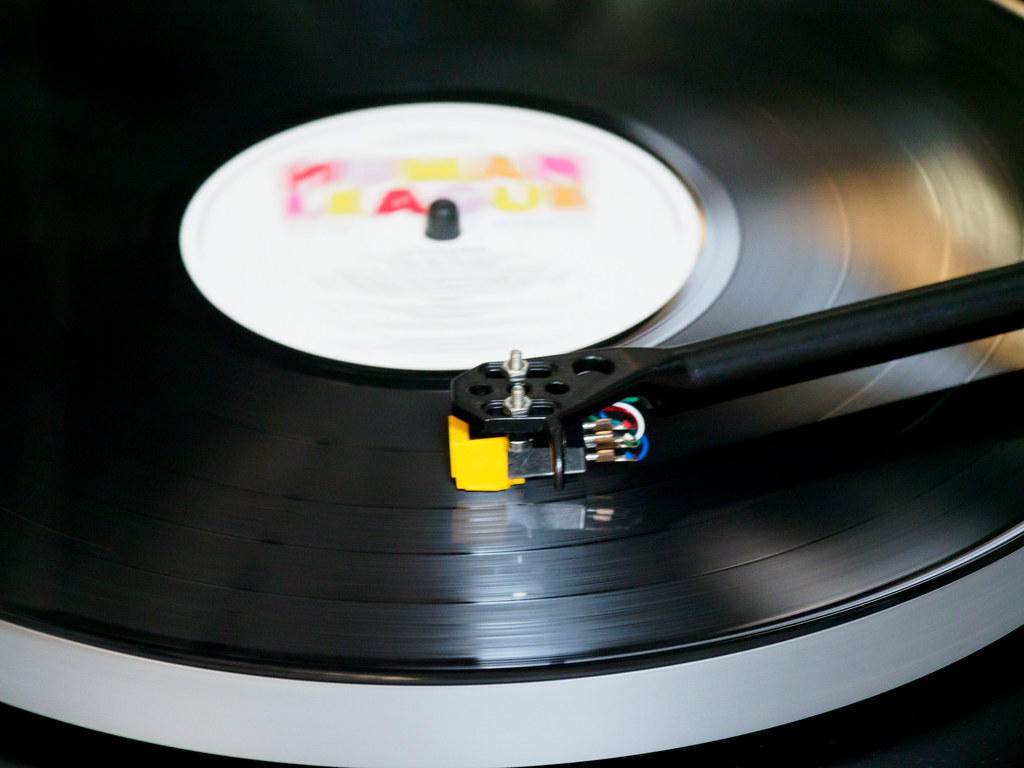This time last year, the New Note Orchestra were recording their first album. “Kind Rebellion” came out in December of 2021 and has been well received. But where did the concept of the modern album come from? And is it still relevant?
The first instance of recorded audio goes all the way back to 1857, when Édouard-Léon Scott de Martinville invented a machine that traced sound waves as a line onto paper or glass. The main problem with this recording was that there was no playback mechanism. Despite further advances from other inventors, Martinville’s recording was not heard until 2008, when a group of sound researchers were able to digitally restore and play back a recording of Au Clair de la Lune made in 1860.
The next significant milestone in audio recording history came in 1877 with Charles Cros inventing the Paleophone, a device that recorded sound onto a cylinder which could then be played back. A similar invention was perfected by Thomas Edison the following year. The next few years, up till 1925, would see a flurry of innovation in audio recording, including experiments with magnetic ribbon, and eventually the creation of an electronic recording process which would result in a disc.
A music-buying public awaits!
The first commercially available discs were 10 inches, ran at 78 revolutions per minute (rpm), and had a playing length of 3–4 minutes per side. Because they were short in time and made of brittle shellac, they would often be sold in booklets of multiple discs that resembled photo albums, hence the word “album” being used to refer to a collection of recordings.
The 33 ⅓ rpm record was developed by Columbia Records and introduced to the market in 1948. These were made with vinyl, which, though more expensive than shellac, is tougher. Crucially, they were 12 inches and could play for 23 minutes per side. Developed specifically for the classical music fan, the first commercially available long-playing (LP) album was Mendelssohn’s Violin Concerto by Nathan Milstein and the New York Philharmonic Orchestra (1948).
The sound of music
The success of Columbia’s classical releases saw other record companies move away from the 78 rpm format. Some of the earliest big-selling LPs were cast recordings of Broadway musicals. Both Oklahoma! and South Pacific were released on dual formats of multiple 78s and single LPs, and both sold over 1 million copies. The official soundtrack of the 1955 version of Oklahoma! would go on to become the first official gold record.
In addition to show tunes and classical music, many early albums were compilations of folk recordings from around the world, spoken word, jazz, and religious music. Though many people might associate the idea of an album with rock or pop music, in the early days of rock’n’roll and blues, the main unit of output was the 7-inch single. Given the belief that the popularity of many acts would be fleeting, the restricted disposable income of teenage audiences, and the reliance on commercial radio play and songwriter systems, 7-inch records were seen as the ideal medium for pop acts to reach their audience.
The dawn of the album era
The LP wasn’t completely ignored by rock and pop acts, though. Most would release albums of songs, often containing their big hits and a number of other tracks to make up the time, pejoratively referred to as “filler.”
The Beatles’ 1965 release Rubber Soul is generally regarded as the first record of “the album era.” The phrase “album era” refers to the period of rock and pop history when the album was the main unit of artistic expression. The mid-1960s marked a turning point when artists would think about their music in terms of complete albums.
The release of Rubber Soul sent shockwaves through popular music. The consistent quality and variety of songwriting, innovative instrumentation, and imaginative production set a blueprint that would be followed for decades. Brian Wilson of the Beach Boys was so impressed by the record that he immediately started work on his opus Pet Sounds (1966), and artists like The Who, Bob Dylan, and the Rolling Stones, among others, were similarly inspired.
Core concepts
Having shaken off the constraints of the 7-inch single, popular artists found new freedom. The Who broke ground with the release of the “rock opera” Tommy in 1969, a collection of songs telling a complete story, though The Kinks, The Pretty Things, and The Small Faces has already attempted similar story albums, albeit on a much smaller scale.
In 1971, Marvyn Gaye released What’s Going On, a story told as a songcycle from the point of view of a Vietnam vet returning home dismayed by the hate, suffering, and injustice he sees. And 1973 saw the release of Mike Oldfield’s Tubular Bells and Pink Floyd’s The Dark Side of the Moon.
The progressive rock movement of the late 60s and early 70s is almost synonymous with the concept album. However, for the first-ever concept album, according to some music historians, you have to go right back to the 1940s.
The voice
The idea of having a singular theme or feel to a music collection is almost as old as the album itself. Some point to Woody Guthrie’s 1940 release Dust Bowl Ballads, a collection of songs about people living in areas of Oklahoma and other prairie states affected by severe dust storms and droughts in the 1930s, as an early concept album. However, it is Frank Sinatra’s 1946 release, The Voice of Frank Sinatra, that probably has the best claim to be the first concept album. The first pop album to be released as a 33⅓ rpm, 12-inch record, Sinatra made use of the LP format to sequence songs that would lyrically make up a narrative story.
All that Jazz
Even before the musical revolutions of the 1960s, people were experimenting with recorded music in LP form. Jazz found a perfect home on LP records, with the lengths of each side being a perfect medium for extended jams. Recorded on March 2 and April 22, 1959, at Columbia’s 30th Street Studio in New York City, Kind of Blue by Miles Davis is widely regarded as one of the greatest jazz albums ever released. The album showcases cutting edge improvisation and rhythmic techniques, melodic beauty and virtuoso musicianship that has influenced not just jazz musicians, but players from all genres of music.
New formats
Though vinyl reigned supreme throughout the 60s and 70s, new formats added to the journey of the album. The first compact cassette tape was Eartha Kitt’s Love for Sale, released in 1966.
The cassette tape saw a surge in popularity in the late 70s and 80s due to the invention of the portable Walkman. The technology required to record tapes was cheap and available. Though many in the music industry became concerned that this made it easy to illegally copy music, it also meant that young musicians were able to record and distribute their own independent albums.
The first digital compact disc, or “CD,” was again a classical recording, a 1979 recording of Chopin waltzes by Claudio Arrau released in 1982. The first pop album to be manufactured was ABBA’s The Visitors, though Billy’s Joel 52nd Street was made commercially available before it.
The audio quality, extended time, and size saw the compact disc outsell vinyl and tapes from the mid-90s to the late 2000s, when the iPod, internet, and e-commerce quickly took hold of music sales.
Electric journeys
Many electronic musicians fully utilised the long-playing nature of the album to create seamless compositions rather than short, single songs.
“Global Communication’s 76:14 is a pearl of 20th century ambient electronica, which I love because I spent so many hours captivated by it at 90s afterparties,” said Crispin, guitarist for the New Note Orchestra.
“To me, an album feels complete when I want to listen to all of it, whatever its musical mood swings or inconsistencies. If I’ve got an emotional connection with an album, it’s like a good friend. I’ll put up with any annoying aspects of its personality because it has interesting or entertaining things to say, too, and because I feel more alive in its company.
Kid A, Doolittle, Rage Against the Machine, Penguin Cafe Orchestra, U.F.Orb, and Kind of Blue are other albums that I’m more likely to listen to in their entirety than eject halfway through.”
An end to the album?
The “album era” is generally said to have ended in the mid-2000s. No longer tied to physical products, artists and record companies don’t have the same constraints that they used to. In a digital world, you can theoretically make an album any length you want. As long as the user can stream it from the cloud, there is no limit to the number of tracks or minutes your album can be.
Paradoxically, though, it seems that the album as it is traditionally known is no longer as important as it once was. The instant availability of music, and music videos, once again emphasise singular songs. Without physical packaging, album artwork is reduced to small digital icons. Popular streaming services such as Spotify and Apple Music shuffle songs or simply continue to play after an album ends, corrupting the idea of an immutable album unit.
And yet the album remains popular. Artists continue to put them out, and cheap recording equipment means that anyone with access to a computer can record their own album and release it. And with an entire world of songs at our fingertips, we now have the opportunity to curate playlists of songs related thematically or emotionally, creating our own personal concept albums.
“Albums still feel alive as a format to me, but they reward a bit of patience and dedication,” said Crispin.
“I feel some nostalgia for a time when I really loved discovering new music and was prepared to spend time getting to know a whole album even if I didn’t like it immediately. These days I’m perhaps too quick to hit the skip button. Partly that’s because I know what I like, but I hope it’s also because I’m quicker at filtering out stuff that isn’t really challenging or interesting. I don’t mind being provoked by music — I just want my discomfort to be intriguing rather than annoying!”
Kind Rebellion
The album era might be over, but the album is not dead. In fact, during 2021, vinyl sales in both the UK and US reached a three-decade high. But more importantly, 2021 saw the release of the debut album from the New Note Orchestra: Kind Rebellion.
Crispin, a seasoned musician, talked about how different the process of recording with an orchestra is from working with a band or as a solo artist.
“It was suitably disappointing. It totally failed to gratify my desire to hear myself clearest in the mix, playing the most prominent parts and generally getting all the glory and kudos. Honestly, I remember listening to the whole album for the first time and thinking, ‘Am I even playing on half of these tracks? I can hardly hear myself!’ Then I listened again and got the orchestra as a whole, felt how the compositions landed, and just melted into it. Which is what I really love about being in the orchestra. It’s a collective enterprise, not an ego trip. It’s a place I can contribute to the best of my musical ability, cultivate openness and patience, and give my energy to something with a higher purpose.”
Released in conjunction with the addiction recovery-based record label Not Saints, the original album explores how acts of kindness impact people and communities over the course of five original tracks.
“The orchestra keeps me well, connected, and positive,” said Crispin. “It’s been a revelation to make music without the booze or drugs that once seemed so essential and to find this genuine delight in playing straight. Music used to be a source of suffering — I never ‘made it’ in the industry, I felt I ought to be a better musician, and performing was always uncomfortable and often humiliating. I mean, just give it up, right!? That’s transformed in the two years I’ve been a member of New Note. I’ve learned to enjoy playing with other people as peers rather than ‘the competition.’ I listen more acutely now, I recover from mistakes quicker — I think I make more interesting mistakes! I feel less judged and less judgemental, more trusting and more trusted. Finding New Note has been my lucky break.”
You can listen to Kind Rebellion here:
https://music.apple.com/album/1592102266



